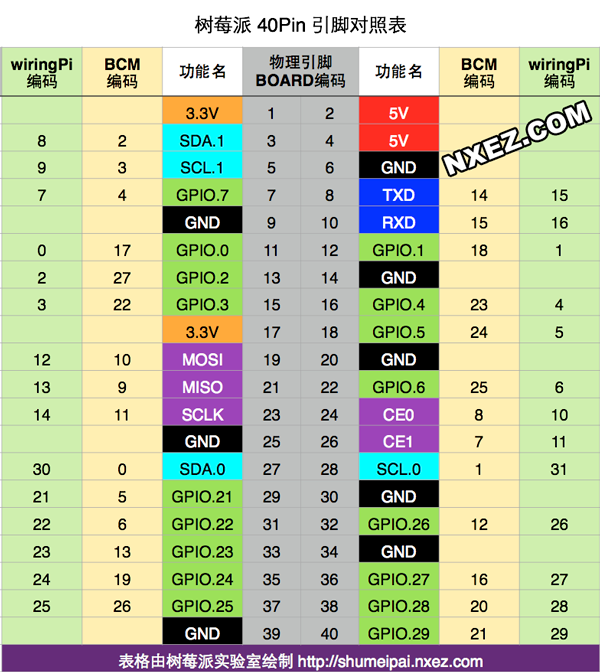硬件说明
带 I2C 模块的 1602 屏幕背面如图所示。模块上有一颗可调电阻,用于调节显示的对比度。(购买链接,如果你新拿到一块屏幕无论怎么调试都不见显示,记得调节一下这里)

接线
| 1 2 3 4 | GND --- GND VCC --- 接树莓派 5V SDA --- I2C 数据 SCL --- I2C 时钟 |


启用树莓派的I2C功能
| 1 2 3 | sudo apt-get install -y python-smbus sudo apt-get install -y i2c-tools sudo raspi-config |
按照下面的步骤设置开启 I2C 功能。





重启树莓派。
| 1 | sudo reboot |
然后运行下面的命令看一下是否识别到屏幕。
| 1 | sudo i2cdetect -y 1 |

看到地址为 0x27,这说明已经成功连接了 LCD1602 屏幕。接下来就可以用 Python 控制 LCD1602 显示信息了。
编程
这里用到一个驱动程序,将下面的代码保存为 LCD1602.py。
| 1 2 3 4 5 6 7 8 9 10 11 12 13 14 15 16 17 18 19 20 21 22 23 24 25 26 27 28 29 30 31 32 33 34 35 36 37 38 39 40 41 42 43 44 45 46 47 48 49 50 51 52 53 54 55 56 57 58 59 60 61 62 63 64 65 66 67 68 69 70 71 72 73 74 75 76 77 78 79 80 81 82 83 84 85 86 87 88 89 90 91 92 93 94 95 96 97 | import time import smbus BUS = smbus.SMBus(1) LCD_ADDR = 0x27 BLEN = 1 #turn on/off background light def turn_light(key): global BLEN BLEN = key if key ==1 : BUS.write_byte(LCD_ADDR ,0x08) else: BUS.write_byte(LCD_ADDR ,0x00) def write_word(addr, data): global BLEN temp = data if BLEN == 1: temp |= 0x08 else: temp &= 0xF7 BUS.write_byte(addr ,temp) def send_command(comm): # Send bit7-4 firstly buf = comm & 0xF0 buf |= 0x04 # RS = 0, RW = 0, EN = 1 write_word(LCD_ADDR ,buf) time.sleep(0.002) buf &= 0xFB # Make EN = 0 write_word(LCD_ADDR ,buf) # Send bit3-0 secondly buf = (comm & 0x0F) << 4 buf |= 0x04 # RS = 0, RW = 0, EN = 1 write_word(LCD_ADDR ,buf) time.sleep(0.002) buf &= 0xFB # Make EN = 0 write_word(LCD_ADDR ,buf) def send_data(data): # Send bit7-4 firstly buf = data & 0xF0 buf |= 0x05 # RS = 1, RW = 0, EN = 1 write_word(LCD_ADDR ,buf) time.sleep(0.002) buf &= 0xFB # Make EN = 0 write_word(LCD_ADDR ,buf) # Send bit3-0 secondly buf = (data & 0x0F) << 4 buf |= 0x05 # RS = 1, RW = 0, EN = 1 write_word(LCD_ADDR ,buf) time.sleep(0.002) buf &= 0xFB # Make EN = 0 write_word(LCD_ADDR ,buf) def init_lcd(): try: send_command(0x33) # Must initialize to 8-line mode at first time.sleep(0.005) send_command(0x32) # Then initialize to 4-line mode time.sleep(0.005) send_command(0x28) # 2 Lines & 5*7 dots time.sleep(0.005) send_command(0x0C) # Enable display without cursor time.sleep(0.005) send_command(0x01) # Clear Screen BUS.write_byte(LCD_ADDR ,0x08) except: return False else: return True def clear_lcd(): send_command(0x01) # Clear Screen def print_lcd(x, y, str): if x < 0: x = 0 if x > 15: x = 15 if y <0: y = 0 if y > 1: y = 1 # Move cursor addr = 0x80 + 0x40 * y + x send_command(addr) for chr in str: send_data(ord(chr)) if __name__ == '__main__': init_lcd() print_lcd(0, 0, 'Hello, world!') |
然后编写一个显示当前时间的示例程序,将下面的代码保存为 time.py。文件需要保存与 LCD1602.py 同一个目录下面。
| 1 2 3 4 5 6 7 8 9 10 11 12 13 14 15 16 17 18 19 20 21 22 23 24 | #!/user/bin/env python import smbus import time import sys import LCD1602 as LCD if __name__ == '__main__': LCD.init_lcd() time.sleep(1) LCD.print_lcd(2, 0, 'WWW.QUWJ.COM') for x in xrange(1, 4): LCD.turn_light(0) LCD.print_lcd(4, 1, 'LIGHT OFF') time.sleep(0.5) LCD.turn_light(1) LCD.print_lcd(4, 1, 'LIGHT ON ') time.sleep(0.5) LCD.turn_light(0) while True: now = time.strftime('%m/%d %H:%M:%S', time.localtime(time.time())) LCD.print_lcd(1, 1, now) time.sleep(0.2) |
其中 LCD.print_lcd() 用来显示字符,前两个参数分别表示 X、Y 坐标(从 0 开始),后面的内容将从这个坐标的位置开始显示。第三个参数就是要显示的内容了。
LCD.turn_light(0) 表示关闭背光,LCD.turn_light(1) 表示打开背光。
在程序目录下执行下面的命令运行。
| 1 | sudo python time.py |

你还可以根据自己的需求,编写显示 IP 地址(参考这里)、系统状态信息的程序,并设置成开机启动(参考这里)来使用这块屏幕。
文章标题:树莓派通过 I2C 驱动 LCD1602 液晶屏 - 树莓派实验室
固定链接:https://shumeipai.nxez.com/2020/06/17/raspberry-pi-drives-lcd1602-screen-through-i2c.html






 /5
/5 


